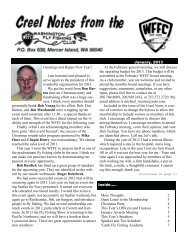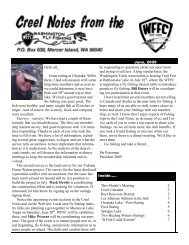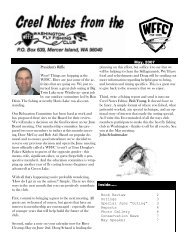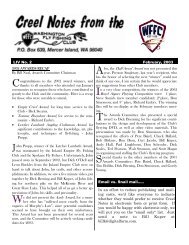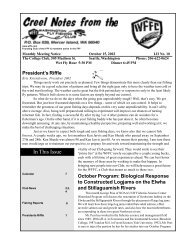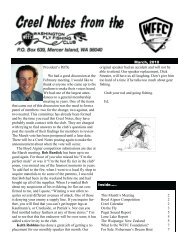Creel Notes - Washington Fly Fishing Club
Creel Notes - Washington Fly Fishing Club
Creel Notes - Washington Fly Fishing Club
Create successful ePaper yourself
Turn your PDF publications into a flip-book with our unique Google optimized e-Paper software.
President’s Riffle<br />
I have just returned from the<br />
Dry Falls outing. What a joy!<br />
On the return trip, I was reflecting<br />
on the various outings I have<br />
attended, both this year and in previous<br />
years. Earlier this year, I<br />
spent the day floating the Yakima<br />
with Chapin Henry. Chapin mentioned that his<br />
“tradition” of floating rivers was chocolate cupcakes. I<br />
was thinking what my “traditions” were. Maybe it is<br />
stopping at McDonalds. The only time I ever stop at<br />
McDonalds is on the morning of an outings trip. I meet<br />
Mark Pratt at the Monroe McDonalds before our Janus<br />
Lake trips. When I go to Dry Falls, I often have a meal<br />
at a restaurant in Ephrata; mostly just to listen to the<br />
conversation. I like coffee, so in Eastern <strong>Washington</strong> I<br />
rely on Starbucks. I know where all of the Starbuck outlets<br />
are located in the areas I fish.<br />
One aspect of the outings that I enjoy is the various<br />
conversations I hear. This last weekend I watched<br />
James Schmidt and Ray Willms. I found out they have<br />
known each other for years; who knew! Last year Jim<br />
Young and I captured a praying mantis at Dry Falls. I<br />
took it back to Seattle to share it with my grandson Anders.<br />
Jim and I talked about the joy of grandchildren. I<br />
enjoy the interplay between Dave Schorsch and Mark<br />
Pratt. These two are champions in my book.<br />
Several years ago, I hiked to Buckskin Lake on the<br />
High Lakes trip. Dick Brening read a newspaper article<br />
about walleye fishing in Minnesota. It was wonderful;<br />
almost better than a campfire ghost story. I will never<br />
forget listening to Maury Skeith telling jokes on the<br />
lakeshore campsite as the last light faded into night and<br />
the campfire lingered.<br />
My point is simple; if you are not participating in the<br />
outings this club provides, you are missing the joy of<br />
being a member of this club.<br />
Thanks,<br />
Mike<br />
Inside…..<br />
October, 2012<br />
This Month’s Speaker 2<br />
On the <strong>Fly</strong> 3<br />
Dry Falls, Mutiny Bay, and the Salt 5<br />
Yakima River Outing 6<br />
Mud Snail 6<br />
Reel Recovery 6<br />
Christmas Party 7<br />
New Member: Jim Goedhart 7
This Month’s Speaker: Bruce Staples<br />
Bruce Staples, of Idaho Falls, Idaho, has fly fished the Greater Yellowstone<br />
area for thirty-five years. He began tying flies in the 1970’s,<br />
and during the 1980’s began writing of his Greater Yellowstone angling<br />
adventures.<br />
His literary contributions include articles to <strong>Fly</strong> Tyer, American<br />
Angler, <strong>Fly</strong> <strong>Fishing</strong> the West, Yellowstone-Teton Country, and <strong>Fly</strong><br />
Fisher magazines. During the 1990’s, he was a columnist for the Idaho<br />
Falls Post Register. His three books, Snake River Country Flies and<br />
Waters (1992), The Yellowstone Park River Journal (1996), and Trout<br />
Country Flies (2003), are published by Frank Amato Publications.<br />
Currently he is contracted with Stackpole Books to author Flies for the<br />
Greater Yellowstone Area. Bruce is an advocate for protection and<br />
preservation of regional coldwater fisheries and is active in preserving<br />
the fly fishing heritage of the Greater Yellowstone region.<br />
Bruce is a member of the Upper Snake River <strong>Fly</strong> Fishers of Rexburg,<br />
Idaho, and the Snake River Cutthroats of Idaho Falls. He is a<br />
driving force behind the East Idaho <strong>Fly</strong> Tying and <strong>Fly</strong> <strong>Fishing</strong> Exposition<br />
and originated its concept. He has demonstrated his fly tying<br />
skills on an international basis. He has taught all skill levels of fly tying<br />
for over twenty years. He is active in the Federation of <strong>Fly</strong> Fishers<br />
(FFF), being recipient of the Western Rocky Mountain Council, FFF,<br />
<strong>Fly</strong> Tier of the Year award in 1990, and the Charlie Brooks Memorial<br />
Life Membership in 1998. In 2001, he was the thirty-second recipient<br />
of the FFF’s Buz Buszek Memorial Award for fly tying excellence. He<br />
is a member of the Whiting Farms and Daiichi Pro Staffs.<br />
2<br />
<strong>Creel</strong> <strong>Notes</strong><br />
...is the official publication of the <strong>Washington</strong><br />
<strong>Fly</strong> <strong>Fishing</strong> <strong>Club</strong>. Subscription is free with<br />
membership.<br />
Jim van de Erve … Editor<br />
425-489-0971 jimvde@comcast.net<br />
Ron Tschetter … Publisher<br />
425-746-6652 batribble@juno.com<br />
President<br />
Mike Wearne michael_wearne@msn.com<br />
1st Vice President (Membership)<br />
John Gravendyk john.gravendyk@boeing.com<br />
2nd Vice President (Programs)<br />
Bob Burdick reburdick@comcast.net<br />
3rd Vice President (Christmas Party)<br />
Open<br />
Treasurer<br />
Don Barton dbarton44@comcast.net<br />
Secretary<br />
Ron Tschetter batribble@juno.com<br />
Ghillie 1<br />
Jim Macdonald macdonaldco@msn.com<br />
Ghillie 2<br />
Peter Draughon pjdrcp@hotmail.com<br />
Trustees<br />
Andrew Bennett ‘10 Craig Koeppler ‘10<br />
Bob Young ‘11 Chapin Henry III ‘11<br />
Don Schroder ’12 Gene Gudger ‘12<br />
<strong>Club</strong> Aims and Purposes<br />
The purpose of this club shall be:<br />
1. To improve and increase the sport of<br />
<strong>Fly</strong> <strong>Fishing</strong> in the State of <strong>Washington</strong>.<br />
2. To promote and work for the betterment<br />
of trout streams and lakes.<br />
3. To encourage and advocate the conservation<br />
and increase of trout,<br />
steelhead, and salmon in state waters.<br />
4. To promote a campaign of education<br />
against pollution in streams, lakes or<br />
Sound waters of the State of <strong>Washington</strong>.<br />
5. To encourage and assist others —<br />
particularly young persons of high<br />
school age—to become fly fishers<br />
and true conservationists.
On the <strong>Fly</strong> by David Ehrich<br />
Mike started off by announcing that he happens<br />
to be the President of the WFFC, which set off a<br />
round of applause. A few guests joined us with two<br />
up for membership. Chuck Ballard started off the<br />
fishing reports with a great report from Chopaka,<br />
including some aggressive damselfly takes late in<br />
the season. Doug Schaad hit High Hume in the<br />
cold, snowy wind where they waited out a few days<br />
of squall to get some 20+ inchers in 20+ degree<br />
weather. Bill Redman pre-announced that his tale<br />
would diverge from fishing and that things didn’t<br />
work out that well on the Ruby, Beaver, Big Sheep<br />
area near Dillon heading up to Big Timber through<br />
clouds of caddis. From there we heard about busted<br />
reservations, bats, sick dogs, rattlesnake bites, antivenom,<br />
and good news. We lost track of the fish, but<br />
the dog survived. Rocco hit the Stilly for smolt, the<br />
Sky for Skunk and the Sultan for Squat. Greg<br />
Crumbaker hit the Clearwater for some smoky<br />
wading and great fishing. Hugh Clark had some<br />
bad fishing at Williams Lake in warm water, but<br />
found good fishing at Horse lake. Then dinner arrived....<br />
Picking up from the steak, President Wearne<br />
opened up the question of renewing the Home Waters<br />
lease on the Yakima. Mike explained that the<br />
lease had been renegotiated from $2500 to $1500 a<br />
year with a one-year option to renew at that price.<br />
Members can also take a guest without cost. A few<br />
of the gentlemen spoke in favor, no one against, and<br />
ballots got passed out.<br />
While the members drew their X’s, Don “the<br />
reformed braggart” Barton introduced our team of<br />
speakers, including Morgan Bond and Eric Waters.<br />
Morgan recounted research the WFFC helped fund.<br />
Morgan, a PhD. candidate at the U. of W., started<br />
with some definition, defining a spectrum of salmonids<br />
from fixed to variable in terms of their migration.<br />
The sea is hands-down the best place to<br />
grow big, but the ocean is a dangerous place with<br />
many mouths. Using char as a test case, Morgan<br />
showed how one lake can host adult char that vary<br />
in almost all ways, including size, feeding scheme,<br />
and variability of migration to open waters.<br />
Next he reviewed the complicated patters of<br />
Dolly Varden migration in a unique ecosystem in<br />
Chignik Lakes, Alaska. Why do they migrate? At<br />
what age? And for how long? He catches fish (with<br />
3<br />
help of fellow member Conrad Gowell) and measures<br />
their otolith, or the stone-like thing in a fish’s<br />
head that helps tell the quarry how to tell up from<br />
down. The otolith grows like a tree, with rings that<br />
reveal its life cycle in terms of life destination. For<br />
example, by looking at the color of the rings, one<br />
can tell if the fish was in fresh or salt water. He uses<br />
a chemical analysis (looking for strontium) to determine<br />
the specific life pattern month by month. One<br />
fish, for example, had a mom who was in the salt,<br />
hit the fresh, hung out for a couple years, headed out<br />
to the salt a few times, and then fell victim to the<br />
hook. After a large pool of study, he discovered<br />
about one fifth start out in fresh water and never migrate,<br />
most do, but the fish with long lives seem to<br />
give up migration. If this reminds you of your love<br />
life, the metaphor is flawed. Remember, the sea is<br />
dangerous; fresh water is safe. So those older fish<br />
avoided the predators, but still had a good time in<br />
fresh water. Take notes, brother, there’s a lesson<br />
here.<br />
Why retire? Well, why take a long trip when the<br />
ocean (as in sockeye return) comes to them and lays<br />
lots of eggs. They eat big in the fall, skinny up in the<br />
winter, and start over again. This growth not only<br />
stretches out their gut for the meal like you do on<br />
Thanksgiving, they also grow bigger livers and<br />
stomachs. Seriously, they eat enough in 5 weeks to<br />
live until ice out. But, here’s the catch, only big fish<br />
can pull this off (regain metaphor here) because only<br />
big (old) fish can eat enough to take advantage of<br />
the reliable feast of sockeye eggs, aka, nature’s perfect<br />
little fat ball of goodness. And here’s the best<br />
(Continued on page 4)
(Continued from page 3)<br />
part; youngsters don’t get much of chance to spawn.<br />
It is the older residents that “show up”, if you know<br />
what I’m saying, at the breeding opportunities.<br />
You might be overwhelmed, but Morgan’s talk<br />
was just the first of two. Next Eric Waters spoke on<br />
Biotelemetry. Eric, lacking credentials in the academic<br />
regions, makes up for lost ground when it<br />
comes to technological tracking of salmonids in the<br />
Columbia system. BioSonics, his company, boasts<br />
several small tracking devices which you might find<br />
in various parts of the next fish you clean. Lotek,<br />
from Toronto, has tracking devices at work around<br />
the world. From listening devices in the river, to fancier<br />
boxes on the shore, they use lots of ways to collect<br />
data. Who, what, where, and when? The funding<br />
comes from the usual suspects: the tribes, the utilities,<br />
NOAA, the BPA, the U.S. Corps of Engineers,<br />
and other smaller players. Such information is handy<br />
to academics like Morgan who get info from living<br />
fish.<br />
Eric believes that the great NW is still managing<br />
to keep salmon populations “in the game” despite<br />
being the most heavily dammed region on the planet.<br />
If one used the money spent as an indicator of health,<br />
then he might be right. In terms of fish count, debate<br />
ensues. He showed some of the ways these fish get<br />
tagged, from needle implants to full-blown sutures.<br />
4<br />
Most handy, in my opinion, was the warning Eric<br />
gave anglers about finding the devices and what the<br />
hardware looks like on the side of the river, from<br />
boats and in the water. Like your phone, the fish<br />
transmit and Lotek has multiple sensors in place that<br />
receive the data and transmit it to a collection center<br />
and from there, the PhD.’s take over and make the<br />
data sing. If you happen to cut open a fish and find a<br />
tagging device, take note of time and place, and give<br />
the number a call. Some dissertation jockey will appreciate<br />
your effort (or tribe or power company or...).<br />
Hugh Clark awarded Gary, our guest fly tier<br />
from the Casting Forward, who tied some mean caddis<br />
- blind! - a nice reel and rod combination donated<br />
by the late Marve Young. Gary finds fly tying easier<br />
than one might imagine once he got the hang of it.<br />
Next we nominated the nomination committee<br />
which took just a few minutes since the pool was talent-packed.<br />
Our prospective members (Ben Davidson & Jim<br />
Goedhart) hit the road and the nip & tuck of member<br />
voting began. Ben is a shoe-string relative of<br />
Mark Pratt, he loves to take fish on the fly, and is<br />
free of gray hair. He also is the guy who found<br />
Schorsch’s oars on Chopaka. ‘Nuff said. Mike Moscynski<br />
gave a good run down about another Boeing<br />
to angler migration. From there, it was a slam dunk.<br />
Committee reports were drown out by chatty<br />
members in the wings. But I think we have a couple<br />
outings on the way. The Foundation added $2500 to<br />
Real Recovery. Dave Hawkinson has retired for<br />
2013 as raffle master. And finally, Bob announced<br />
that Bruce Staples will speak about the Henry’s Fork<br />
& South Fork of the Snake River and other small waters<br />
in the area.
Dry Falls Lake Outing by Dave Schorsch<br />
We had 36 members and guests attend a sunny<br />
outing to Dry Falls Lake Oct 6 th and 7 th .<br />
The lake is at the lowest level ever seen by anybody,<br />
with the “aquarium” section now completely high<br />
and dry. The “shark flats” area is 6 to 8 inches above<br />
water level. Scary low. The fishing, however, still<br />
remains pretty good. Those who hit the early morning<br />
“feed” that happens at first light, got lots of nice<br />
big fish on top. <strong>Fishing</strong> dropped off after 8:00 until<br />
the evening hatches started, with damsel adults and<br />
cream mayflies being the ticket. As usual at this lake,<br />
the early birds get the worms. If you dinked around<br />
and got on the water at mid-morning, you probably<br />
didn’t do very well. The fish that were caught were<br />
very fat and healthy.<br />
Happy hour was awesome, with lots of chow, as<br />
usual. Mike Wosinski brought a ton of sweet corn,<br />
and grilled it to perfection for everybody to have<br />
with their steaks. There is a total fire ban in the state,<br />
so we couldn’t have our bonfire, or club charcoal<br />
grill. Several volunteers brought their home gas grills<br />
for the barbeque, with seven set up for dinner. Without<br />
a fire, we decided not to have folks sit around in<br />
the cold and dark to listen to music, so it ended up a<br />
pretty early evening. All in all a great evening,<br />
though.<br />
Sunday, some went back to Dry Falls, and others<br />
went to Jameson Lake, where lots of dumb trout<br />
were found on the way home.<br />
Thanks to everyone who helped out on this year’s<br />
fall outing, we all had fun. Maybe next year everything<br />
won’t be on fire.<br />
Mutiny Bay/Admiralty Inlet West Shore<br />
by Don Gulliford<br />
For first time in several years, a young guy waded<br />
out for sea-run cutts, using a green and white Clouser<br />
Minnow, short sink tip on floater line on beautiful<br />
weather and tide, but success. It look nice on coming<br />
5<br />
dismal, drismal cold rainy days. The floating line is<br />
needed because of large amounts of eel grass that<br />
usually loosen up silver salmon and cutt fishing,<br />
making jigs like BuzzBombs and Rotators necessary<br />
to get down past weeds. Couple of 8 pounders I got<br />
in 15 minutes 10/4 with such jigs off beach.<br />
<strong>Fishing</strong> the Salt by Bob Young<br />
I’ve been waiting a long time for the silvers to<br />
return, and finally some have showed up. In the last<br />
couple of weeks, I have managed to hook and land<br />
seven silvers and one chum. The chum was pretty<br />
colored up and had big ugly teeth, but the silvers<br />
have all been bright and shiny. Most have been better<br />
than 8 lbs.<br />
<strong>Fishing</strong> a small chartreuse flashabou comet pattern<br />
tied on a #4 Gamakatsu bait hook with a 6 wt.<br />
rod and a slow intermediate line has done the trick.<br />
There was a lot of casts between hook-ups, however.<br />
Most of the fish were taken while casting from a<br />
small boat just off of the mouth of the creek entering<br />
Colvos Passage at Olalla. One was taken off a beach<br />
within sight of the state capital building.<br />
The first morning we arrived at Ollala, some native<br />
Americans were just hauling in a large beach<br />
seine with quite a number of nice fish. They didn’t<br />
get all the fish, though, as we managed to land three<br />
later in the day.
(Continued from page 5)<br />
Yakima River Outing by Dave Schorsch<br />
The club had a day trip to the Home Waters section<br />
of the Yakima river on Saturday, Sept. 29 th . For<br />
those of us who had never fished it, like me, it is<br />
pretty impressive water.<br />
The river is big, but crossable in several places at<br />
fall level. Lots of structure, and long riffles dropping<br />
into deep runs under the trees. I’d like to say<br />
we hit tons of big fish, but we were limited to<br />
mostly little guys whacking dries and nymph droppers.<br />
Biggest beast of the day, probably 12 inches.<br />
Eight club members fished pretty hard ‘til<br />
around 1:00 and regrouped at the Home Waters<br />
buildings to console ourselves with cold beverages<br />
and lunch. Chapin Henry and Mike Wearne<br />
floated the river in the same area with the same results.<br />
We all saw fish working occasionally, but just<br />
couldn’t outsmart them. Definitely a “match the<br />
hatch” scenario.<br />
A beautiful day on a pretty river, with much to<br />
learn.<br />
Mud Snail Infestation<br />
On a depressing note, it has been confirmed that<br />
New Zealand Mud Snails are in Valley and Kelsey<br />
Creeks. Please be VERY careful if you are moving<br />
anywhere in the watershed. Since it’s confirmed in<br />
Thornton Creek in Seattle, and in Valley and Kelsey<br />
Creeks, there may be other places, as well. These<br />
are nasty little critters with no means of eradication.<br />
They’re tough enough to be eaten by fish and survive<br />
– starving the fish in the process and potentially<br />
allowing the fish to transport them to other<br />
areas. The most common means of mobility,<br />
though, are humans – catching a ride on boots, gear,<br />
pant cuffs, etc.<br />
People need to NOT use felts (which stay damp<br />
for weeks), clean their gear at the stream, brushing<br />
off ANY mud or sand – the snails are about the size<br />
of a grain of wild rice. Then, completely dry your<br />
gear for 48 hours prior to getting into another<br />
stream. If you don’t have 48 hours, a 120 deg. F.<br />
water bath for 5 minutes will also kill them. 409<br />
cleaner works, but degrades the gear and can pollute<br />
the next stream. Bleach and other typical cleaners<br />
don’t work on mud snails.<br />
For more information: http://<br />
seagrant.oregonstate.edu/sgpubs/onlinepubs/<br />
g10001.pdf.<br />
(This article is reprinted from KPaulsen@bellevuewa.gov.)<br />
Reel Recovery by Dick Brening<br />
At the September Reel Recovery Retreat for men<br />
with cancer, your WFFC donated a handcrafted fly<br />
box and six dozen flies tied by members at the<br />
monthly <strong>Fly</strong> Tyer’s Round Table.<br />
Kris Kristoferson, Event Coordinator and<br />
WFFC Member, displays the donated box of flies.<br />
Closeup photo of the flies tied by WFFC members<br />
and donated to the Reel Recovery Program.<br />
6
2012 Annual Christmas Party and Fundraiser<br />
by Bob Young<br />
This year's event will be held on Tuesday, Dec.<br />
11 th , at our usual meeting place the fabulous Seattle<br />
Tennis <strong>Club</strong>. So be sure to mark your calendar. The<br />
menu is not set yet, but the price will be about $65 a<br />
dinner.<br />
7<br />
New Member Autobio: Jim Goedhart<br />
Born and raised in Southern California on a<br />
dairy, and learned fishing from my father who fished<br />
with conventional gear for Yellow Tail and Albacore<br />
out of Point Loma in San Diego. I started trout<br />
fly fishing when I went to school at Chico State in<br />
the mid-sixties and in the early nineties, salt water<br />
fly fishing with my wife Caroline, in Rhode Island,<br />
Islamorada, and the Bahamas. We moved to Sammamish<br />
in 1998 from Chicago, and have fished<br />
mainly on the Yakama with trips to Alaska, B.C.,<br />
Utah, Oregon, Mexico, and Christmas Island over<br />
the past years. My two sons, who both fly fish and<br />
live in <strong>Washington</strong>, and I went to Belize the year<br />
before last on a trip organized by Jimmy Lemert. I<br />
look forward to learning more about fly fishing and<br />
where to go fishing from the WFFC membership.
<strong>Washington</strong> <strong>Fly</strong> <strong>Fishing</strong> <strong>Club</strong><br />
P.O. Box 639<br />
Mercer Island, WA 98040<br />
www.wffc.com<br />
October, 2012<br />
Meeting Announcement<br />
Meetings are held on the third Tuesday of each month at the Seattle Tennis<br />
<strong>Club</strong>, 922 McGilvra Blvd. E.<br />
The Wet <strong>Fly</strong> hour begins at 5:30 PM and dinner is served at 6:45 PM.<br />
This month:<br />
Bruce Staples on <strong>Fly</strong> <strong>Fishing</strong> Gems of SE Idaho<br />
Stamp<br />
here



